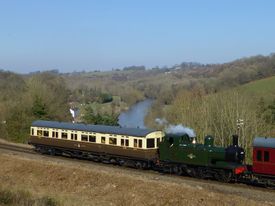| GWR 178 Autotrailer Third | |
|---|---|
 Autocoach 178 behind GWR 1450 | |
| Built By | GWR Swindon |
| Status | In service |
| Number | 178 |
| Other numbers | W178, W178W |
| History | |
| Built | 1930 |
| Designed By | Collett |
| Diagram | A28 |
| Lot | 1410 |
| Length | 62ft 8in |
| Weight | 30t (approx) |
| Seats | 72 third |
| 1969 | Preserved on SVR |
| 1979 | Left SVR |
| 2014 | Returned to SVR |
The GWR Autocoach, sometimes called an autotrailer, was used by the Great Western Railway for push-pull trains powered by a steam locomotive. The autocoach has a driving cab at one end, allowing the driver to control the train without needing to be on the footplate of the locomotive. This eliminates the need for the engine to run round to the other end of the coach at the end of each journey. The combination of locomotive and autocoach(es) is known as an auto-train or, historically, a railmotor train, and they were mainly used on small branch lines.
Steam locomotives provided with the equipment to be used as an auto-train are said to be auto-fitted. The driver operates the regulator, brakes and whistle from the autocoach; the fireman remains on the locomotive and in addition to firing, also controls the valve gear settings. The driver, guard and fireman can communicate with each other by an electric bell system.
Many Autocoaches were rebuilt from steam railmotors, although both examples on the SVR were built as autocoaches from new.
Contents
Service
178 was built at Swindon in 1930 as part of Lot 1410 to Diagram A28.[1] Its working life ended at Wolverton.[2]
Preservation
178 first arrived on the SVR on 1 January 1969, owned by Mr D R Gwynne-Jones.[2] In Autumn 1975 the SVR announced that 178 and GWR 6562 Brake Composite were to be acquired from Mr Gwynne-Jones by The Great Western (SVR) Association.[3] However 178 left the SVR in 1979, moving to the Dean Forest railway.[1]
178 returned to the SVR in March 2014 along with Mike Little’s other autocoach 238 and auto-fitted locomotive GWR 1450.
Gallery
See also
References
Links
178 on Railway Heritage Register On-Line
| ||||||||||||||||||||||||||||||




